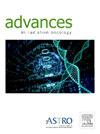靶向活性小胶质细胞减轻质子辐射诱导的远端神经损伤
IF 2.7
Q3 ONCOLOGY
引用次数: 0
摘要
目的质子治疗(PT)在避开邻近正常组织的同时,能够精确靶向肿瘤,具有明显的优势。然而,PT的远端边缘效应限制了其应用。本研究研究了质子远端边缘区域的脑组织反应,并将其与光子效应进行了比较。方法和材料在小鼠模型中研究了光子和质子远端边缘损伤的发生。优化小鼠模型的Bragg峰治疗方案。沿远缘进行苏木精、伊红和免疫荧光染色。此外,还计算了布拉格峰到神经元损伤位点的近似距离。此外,研究了一种小分子抑制剂抑制小胶质细胞激活的能力。结果成功建立小鼠远端边缘脑损伤模型。质子照射组脑右半球出现反应性胶质瘤和颗粒空泡神经元变性。沿远端边缘多处(额叶、丘脑、大脑皮质)可见神经元损伤,但沿垂直光子照射暴露区未见神经元损伤。同时,水平光子照射可造成严重的神经损伤。在Bragg峰远端边缘(0.4633±0.01856 cm)处,形态异常的小胶质细胞聚集。IBA1和CD68染色显示在相应的神经元损伤部位有激活的小胶质细胞,表明它们参与了辐射诱导的损伤。垂直光子照射未观察到活化的小胶质细胞,而水平光子照射观察到许多活化的小胶质细胞。此外,通过腹腔注射天冬酰胺内肽酶抑制剂可显著降低丘脑和大脑皮层的活性小胶质细胞,减轻脑损伤。结论质子辐射可引起神经损伤,激活的小胶质细胞在远端边缘聚集。靶向活化的小胶质细胞可能在远端辐射损伤中起保护作用。本文章由计算机程序翻译,如有差异,请以英文原文为准。
Targeting Active Microglia Alleviates Distal Edge of Proton Radiation-induced Neural Damage
Purpose
Proton therapy (PT) has distinct advantages in its ability to precisely target tumors while avoiding adjacent normal tissues. However, the distal edge effects of PT constrain its application. This study investigated the brain tissue response in the distal edge regions of protons and compared it with the effect of photons.
Methods and Materials
The occurrence of damage from photons and at the distal edge of protons was investigated in a murine model. Bragg peak treatment plans for murine models were optimized. Hematoxylin and eosin and immunofluorescence staining were performed along the distal margin. In addition, the approximate distance from the Bragg peak to the neuronal damage sites was calculated. Furthermore, a small-molecule inhibitor was studied for its ability to inhibit microglia activation.
Results
The distal edge brain injury murine model was successfully established. Reactive gliosis and granulovacuolar neuronal degeneration were observed in the right hemisphere of the brain in the proton irradiation group. Neuronal injuries were observed at multiple locations (the frontal lobe, thalamus, and cerebral cortex) along the distal border, but no injured neurons were detected along vertical photon irradiation exposed areas. Meanwhile, severe neural damage was seen with horizontal photon irradiation. At the distal edge of the Bragg peak (0.4633 ± 0.01856 cm), microglia with abnormal morphology accumulated. IBA1 and CD68 staining revealed activated microglia at the corresponding neuronal damage sites, indicating their involvement in irradiation-induced damage. Activated microglia were not observed with vertical photon irradiation, whereas many activated microglia were observed with horizontal photon irradiation. Moreover, asparagine endopeptidase inhibitors administered via intraperitoneal injection significantly reduced active microglia in the thalamus and cerebral cortex and alleviated brain damage.
Conclusions
This study demonstrated that proton radiation induces neuronal damage and accumulation of activated microglia at the distal edge. Targeting activated microglia may play a protective role in distal edge injury from radiation.
求助全文
通过发布文献求助,成功后即可免费获取论文全文。
去求助
来源期刊

Advances in Radiation Oncology
Medicine-Radiology, Nuclear Medicine and Imaging
CiteScore
4.60
自引率
4.30%
发文量
208
审稿时长
98 days
期刊介绍:
The purpose of Advances is to provide information for clinicians who use radiation therapy by publishing: Clinical trial reports and reanalyses. Basic science original reports. Manuscripts examining health services research, comparative and cost effectiveness research, and systematic reviews. Case reports documenting unusual problems and solutions. High quality multi and single institutional series, as well as other novel retrospective hypothesis generating series. Timely critical reviews on important topics in radiation oncology, such as side effects. Articles reporting the natural history of disease and patterns of failure, particularly as they relate to treatment volume delineation. Articles on safety and quality in radiation therapy. Essays on clinical experience. Articles on practice transformation in radiation oncology, in particular: Aspects of health policy that may impact the future practice of radiation oncology. How information technology, such as data analytics and systems innovations, will change radiation oncology practice. Articles on imaging as they relate to radiation therapy treatment.
 求助内容:
求助内容: 应助结果提醒方式:
应助结果提醒方式:


